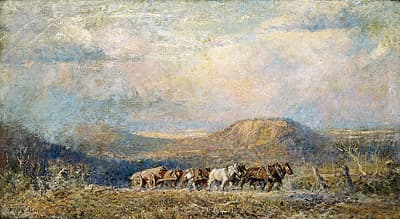Frederick
MCCUBBIN
Australia
1855
–
1917
Hauling timber, Macedon Heights
1911
oil on canvas
signed and dated 'F McCubbin 1911' lower left
78.7 (h)
x 140.0 (w)
cm
Private collection
When a painting entitled Hauling timber was shown in McCubbin’s 1912 exhibition at the Athenaeum Gallery, it was said to depict ‘a typical stretch of the Hanging Rock country’. The critic added that it portrayed this landscape ‘under one of its loveliest effects, beneath the shade of passing clouds, with the sides of the hillocks catching the light from a wonderfully luminous sky’ (Age, 14 August 1912, p 9). The reviewer continued to observe that McCubbin depicted the plains below Mount Macedon, with Hanging Rock in the background. Such a description would appear to fit this particular painting. However, the price listed in the catalogue for the reviewed work was a mere 80 guineas—which appears a low price for such a substantial work as Hauling timber, Macedon Heights when compared with 120 guineas for Afterglow (or as that work was referred to in the catalogue, ‘Summer evening’) (cat 51). Perhaps there was a mistake in the catalogue, and Hauling timber should really have been 180 guineas. Or perhaps it is just an example of the way that the prices for McCubbin’s work were uneven—and cannot be used as more than a broad basis for identifying his work.
McCubbin had earlier made a small sketch of this same area in Looking towards Hanging Rock from Mount Macedon (cat 43), in which he revelled in the colours of the scene. In Hauling timber, McCubbin enlarged the sky, depicting clouds lit up by the sun. And, as Bridget Whitelaw has observed, he applied his paint thickly, creating a landscape of ‘tumultuous colour’, with ‘an explosion of luminous pink and blue light in the sky’ and with the blue shadow of the valley providing ‘a startling contrast to the flickering colour of the foreground’ (McCubbin 1991–92, p 102).
As the work’s title suggests, McCubbin included in this landscape the very Australian subject of a team of draught horses, ‘hauling timber’. But this subject is integrated into the scene, rather than being its main focus—as it is for instance in George W Lambert’s best-known bush image, Across the black soil plains 1899 (AGNSW). For McCubbin the horse team was just one element in the landscape, while for Lambert it was his central subject. McCubbin melded his subject into the landscape, while Lambert dramatised the scene by adopting a low viewpoint and silhouetting the horses against the sky, emphasising the team and the rhythmic rise and fall of the animals. McCubbin depicted a poetic landscape enlivened by a horse team, whereas for Lambert the horse team was his subject.
McCubbin’s inclusion of a team of draught horses moving large logs through the plains to the sawmills was based in fact. The village of Hesket, in the valley below Mount Macedon about a kilometre from his home, was the centre of the local timber industry. The timber included mountain ash, messmate, peppermint, white gum and manna gum trees. Even though much of the timber had been cut down by 1911, the industry was still important to the district.
